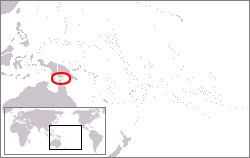Torres Strait Islands
|
Torres Strait Islands |
|
|---|---|
|
Anthem: Advance Australia Fair
|
|

Location of the Torres Strait Islands, between Cape York Peninsula, Queensland, Australia and Papua New Guinea.
|
|
| Capital and largest city |
Thursday Island |
| Official languages | English; important local languages: Kalau Lagau Ya, Meriam Mir, Torres Strait Creole |
| Demonym | Torres Strait Islander |
| Government | Regional authority |
|
• Queen
|
Elizabeth II |
|
• Chairpersona
|
Joseph Elu |
|
• Chief Executive Officera
|
Wayne See Kee |
| Regional authority | |
|
• Established
|
1 July 1994 |
| Population | |
|
• 2011 census
|
4,248 |
| Currency | Australian dollar (AUD) |
| Internet TLD | .au |
|
|
The Torres Strait Islands /ˈtɔːrᵻs/ are a group of at least 274 small islands which lie in Torres Strait, the waterway separating far northern continental Australia's Cape York Peninsula and the island of New Guinea.
The islands are mostly part of Queensland, a constituent State of the Commonwealth of Australia, with a special status fitting the native (Melanesian) land rights, administered by the Torres Strait Regional Authority. A few islands very close to the coast of mainland New Guinea belong to the Western Province of Papua New Guinea, most importantly Daru Island with the provincial capital, Daru.
Only 14 of the islands are inhabited, with many of the islands threatened by rising sea levels.
The indigenous inhabitants of the Torres Strait Islands are the Torres Strait Islanders, an ethnically Melanesian people who also inhabited the northern tip of Cape York Peninsula, distinct from the Australian Aborigines who are the Indigenous Australians in the rest of the country.
The Portuguese navigator Luís Vaz de Torres explored Torres Strait in 1606. Torres had joined the Queirós expedition which sailed from Peru across the Pacific Ocean in search of Terra Australis.
...
Wikipedia
